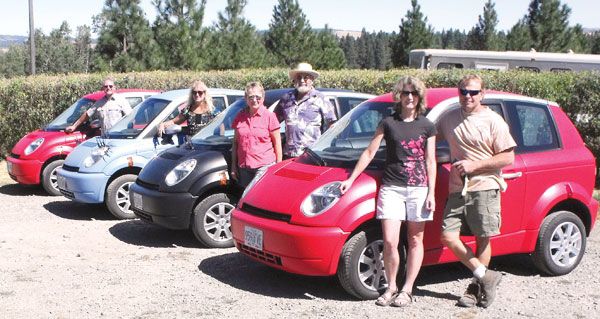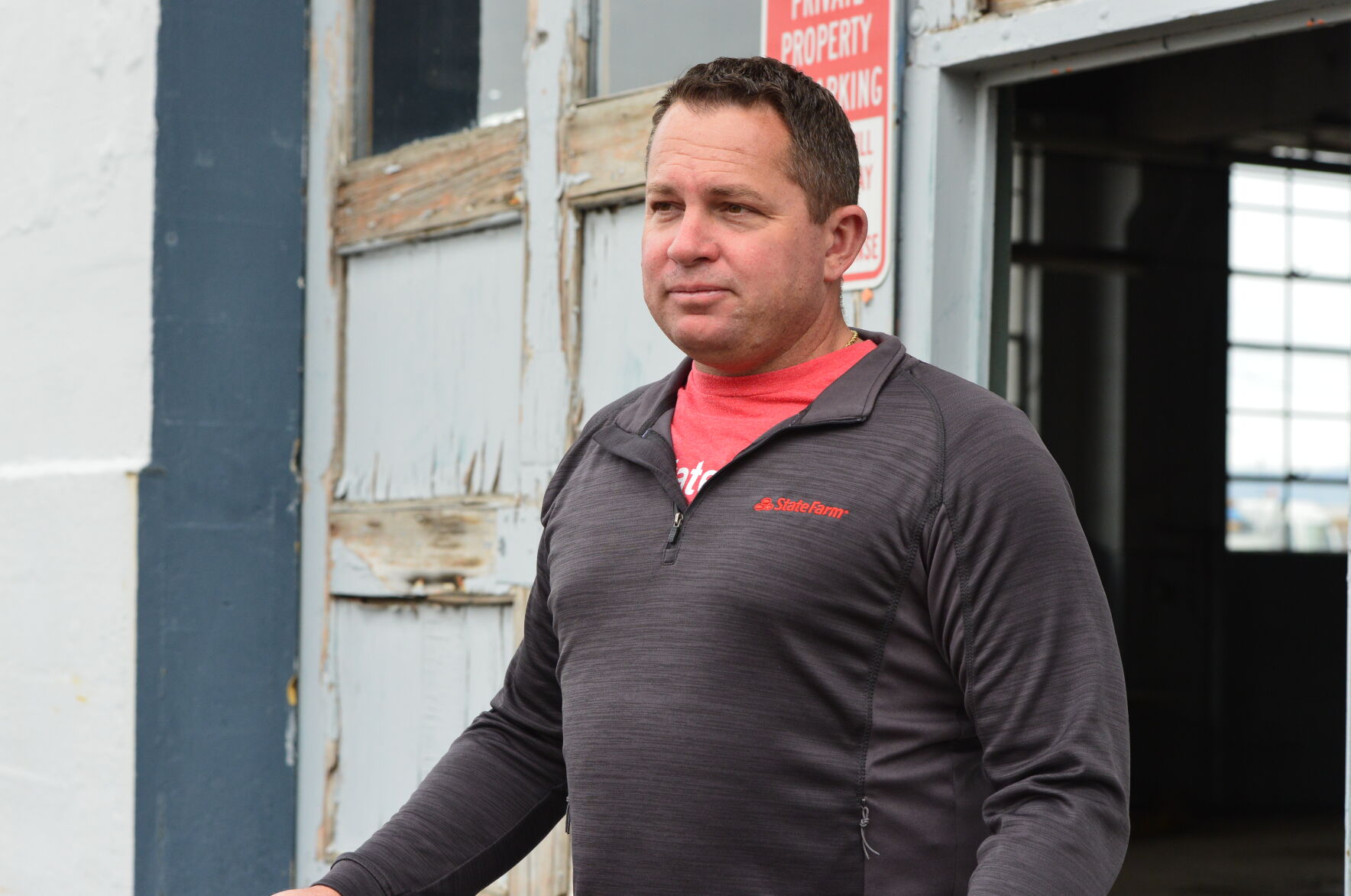All electric Think City cars roll into Northeast Oregon
Published 3:44 pm Wednesday, November 14, 2012

- These six Think City car owners in Union County are impressed with the electric-powered technology and performance of their vehicles. From left, are Steven Bartell, Tempe Bartell, Theresa and Howard Butts, and Stacey and Forrest Warren.
There are currently 110 all electric Think City vehicles cruising Oregon’s city streets, including four that made their clean and quiet debut in Union County.
Eco-technology conscious buyers like Howard and Theresa Butts and Forrest and Stacey Warren of Summerville, and Steven and Tempe Bartell of Imbler all did their home work and could not pass up the opportunity to go electric. After all, it’s good for the environment and even better on the wallet.
Butts said, “I saw the handwriting on the wall in the 1990s, when the price of gasoline was $2.53/gallon and rising.”
He was already using solar power at home, and he had two electric bicycles and a 1994 S-10, 5,000-pound electric truck in his garage, so graduating to the Think City EV seemed to him the best way to stay ahead of the energy game and save hard-earned dollars.
“I’m proud of the fact that I can be a trail-blazer in this regard,” said Butts. “Look at the irreparable harm we’re doing to our earth with oil drilling, spills and auto emissions. And the cost? For every penny increase in gasoline, it costs Americans $1.25 billion more per year at the pump. They say, ‘We expect that to get cheaper any time’-right!”
Today Butts smiles as he drives by the gas stations knowing he is saving thousands of dollars this year in fuel. He goes home and recharges his plug-in Think car over night, drawing on electrical power generated by photo-voltaic solar panels.
“It cost me two cents a mile to run my car, and to charge my car using photo voltaic panels, it cost me zero cents,” said Butts.
The Think company
The Think City vehicle is a fifth generation Think model produced from 2008 to 2011 by Think Global which was purchased by a Russian investor. It was first manufactured in Europe about 11 years ago, butit didn’t roll off the assembly line to consumers here until May 2012. The Think City EV chassis is produced in Finland, shipped to the United States and finished on the assembly line at the Think plant in Elkhart, Indiana. But last August, the plant suspended its operations.
“The Think company is undergoing a transformation.” said Jim Houser, co-owner with Liz Dally of Hawthorne Auto Clinic of Portland, the authorized Think City warranty service and repair center in Oregon. “They are working on three models, one to replace the Think City model, one that’s an urban delivery type of truck or van, and for the 2014, they are working on a four-door sedan. A lot depends on the U.S. and world economies and on politics. There’s still a lot of government support required for these new technologies, and who knows what’s going to be available for that.”
While the Elkhart plant remains dormant, Think research and development continues on future models. “There is a 2013 model under development at the engineering firm in Germany. They have a prototype, and it’s based a lot on the Think City cars but there are improvements.”
Think City has a popular following. There are between 20-25 Oregon buyers on a waiting list for the EV, and Houser anticipates that these orders will be fulfilled by drawing on still unsold Think City cars from southern California, Maryland and other places around the country. They cost $16,000 and come with a sweet federal energy income tax credit of up to $7,500 based on the buyer’s income level and the price of the car. So the final cost “makes it pretty darn reasonable for a nice commuter car,” said Houser.
The two-seater, one ton Think City has a steel chassis and a recycled acrylonitrite butadiene styrene or ABS plastic body, known for its tough, impact resistant properties. It’s wrinkled texture and flat-matte finish easily hide minor scratches and touch up paint. To top it off, the Think City has a five star crash rating, two air bags, a steel chassis with an extruded aluminum cage, and it meets all the federal highway safety standards.
The Think City is operated by a rechargeable Lithium ion battery and has a top speed of about 68 mph. Manufacturers of the battery now include the Chinese and Koreans who are eager to serve themselves a slice of the American auto pie. Houser receives numerous marketing emails from these countries wanting to sell hundreds of batteries to him.
Range
If consumers have any concerns about electric vehicles, they can be summed up in two words, “range anxiety.” How far can an all electric vehicle go on a full charge? According to Houser that varies.
“For urban commutes, the car range is about 100 miles, but in the winter it’s between 70 and 90,” said Houser. “Going up steep hills takes away some of that range, but in summer, the electrical range is between 90 and 110 miles.”
Houser said that charging stations are really popular in the Portland’s parking lots. Some lots have spaces for something they call “fast chargers” but they don’t work with the Think car. Merchants want chargers in their parking lots to attract people to their shopping district while their car recharges.
“Most recharging stations do not cost anything, but some companies are putting them in and you use something like a visa card you swipe through,” said Houser. “Some companies put up meters near their buildings for their employees. Intel does that and CH2M HILL has several meters for their employees in their parking lot. We have them too.”
If the vehicle’s battery is totally depleted, recharging may take 6 to 8 hours (at 220 volts) Houser said, but if it is down 30 percent from its full charge, then it takes about one hour. On average most recharging takes between 45 minutes and an hour and a half.
Butts said he doesn’t let the battery go too low before he recharges. “I recharge it around 30 percent at 12 amps of 110 volts at home overnight,” he said. “That’s it.”
Another feature he likes are the ABS brakes. When the driver puts the car into D mode, the vehicle will coast to a stop like fuel-powered vehicles, but when driving in E (efficiency) mode, the vehicle resorts to regenerative braking, pumping electricity back into the high voltage battery. The E setting uses less electricity, slows down quietly and quickly and without using the brakes much at all. This, of course, saves on brake maintenance and repairs.
Maintenance
“There’s so much less maintenance on the Think City,” said Houser. “There’s no oil changes, spark plugs, a little antifreeze, but no muffler, no emission control systems, oxygen sensors and all those elaborate, expensive emission control systems that help for fuel economy and emissions but that all cost money to install and later break down. There’s no need for a body shop to hammer out the wrinkles and paint it. With an EV, you just buy a new plastic panel and bolt it on. The first real service on the Think car is 3 years/36,000 miles. Then you change the quart of oil in the transmission and bleed the brake fluid and rotate tires. That’s about it.”
Service on the Think City cars in Union County is available from Ken Trice (910-2910), who trained in Portland with the Think City assembly team from Elkhart, Ind.
Houser believes that this technology is developing slowly enough that dealerships like his will stay busy enough with so many gasoline cars still on the road, but eventually, in the same way we had to get away from buggie whips and horse shoeing, the work force will adapt to the new alternate energy cars like Think City.
For more information on Think City EVs, contact Houser at 503-234-2119.





